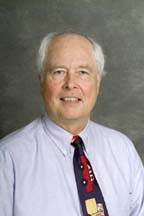Remembering Stewart (Stu) Loken (1943-2011)

Remembering Stewart (Stu) Loken
1943-2011
Stewart (Stu) Loken passed away on February 19, 2011 after a long and courageous battle with cancer. He was 68. Stu was a Senior Scientist in the Physics Division of Lawrence Berkeley National Laboratory, having worked at Berkeley Lab for 37 years. More than half that time, some 20 years, was devoted to service in Lab management. His most recent appointment was as Deputy Director of the Physics Division, in which he was active until late 2010. Previously, as Director of the Information and Computing Sciences Division (forerunner of the multidivisional Computing Sciences organization) from 1988 to 2000, Stu created both the Technical and Electronic Information Department, forerunner of today’s Creative Services Office, and the Computing Infrastructure Support Department, forerunner of the Information Technology Division; perhaps most significantly, he is credited with having laid the groundwork for bringing NERSC (the National Energy Research Scientific Computing Center) to Berkeley Lab, and for having helped create the Department of Energy’s ESnet and bringing its headquarters here.
Stu was born in Canada, in Montreal, Quebec, on February 16, 1943. He received his undergraduate B.Sc. degree in Applied Mathematics and Theoretical Physics from Ontario’s McMaster University in 1965. He then pursued graduate studies in physics at the California Institute of Technology and received his Ph.D. degree from Caltech in 1972, with a dissertation in experimental high energy physics. He became a naturalized United States citizen in 1991.
Stu began his Berkeley Lab career as a postdoc in the Physics Division in October 1974, became a Division Fellow in 1977, and by June, 1981 had advanced to Senior Scientist. An internationally known and respected physicist, his wide range of research interests at Berkeley Lab included muon-nucleon interactions at Fermilab’s E203/391 deep inelastic muon scattering experiment; electron-positron collider physics with the Time Projection Chamber experiment at the Stanford Linear Accelerator Center; hadron collider physics with the D-Zero experiment at Fermilab’s Tevatron Collider, and more recently with the ATLAS experiment at CERN’s Large Hadron Collider; particle astrophysics with the Nearby Supernova Factory based at Berkeley Lab; and, as late as 2010, a search for dark matter particle candidates with the Sanford Underground Laboratory’s LUX experiment at the Homestake Mine in South Dakota.
In 1990 Stu was elected Fellow of the American Physical Society. Committed to education and outreach, he was a leader in QuarkNet, which provides professional development and support for physics teachers through hands-on training and research appointments. Both as the Director of Information and Computing Sciences and as a member of the Physics Division, he worked tirelessly